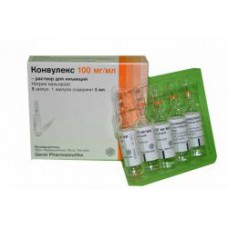Expiration date: 11/2028
Structure and Composition:
Solution for intravenous administration. 5 ml contains valproic acid, 433.9 mg
(Corresponding to 500.0 mg of sodium valproate)
Excipients: sodium hydroxide - 117 mg Disodium hydrogenphosphate dodecahydrate - 71.8 mg Water for injection - up to 5 ml
in 5 ml ampoules in a package of contour plastic 5 ampoules in a cardboard bundle one package.
Description pharmaceutical form:
The clear colorless or nearly colorless solution.
Pharmacokinetics:
The equilibrium concentration at / in the introduction is achieved within a few minutes and can be maintained by slow infusion administration. Therapeutic drug concentration in the blood plasma varies from 50-150 mg / l. Valproic acid is bound to the plasma protein at 90-95% - at plasma concentrations up to 50 mg / l and 80-85% - at a concentration of 50-100 mg / l with uremia, hypoproteinemia cirrhosis and reduced protein binding. Levels in the CSF correlate with the unrelated protein fraction of the drug, accounting for about 10% of the level in the serum. Valproic acid crosses the placental barrier, excreted in breast milk. Concentration in breast milk is 1-10% concentration in maternal blood plasma. The drug undergoes glucuronidation and oxidation in the liver metabolites and unmodified valproic acid (1-3% of the dose) excreted by the kidneys, small amounts are excreted in the feces and expired air. T1 / 2 of the drug in healthy subjects and in monotherapy from 8 to 20 hours when combined with other drugs, T1 / 2 can be 6-8 hours due to the induction of metabolic enzymes in patients with hepatic impairment and elderly patients - can be much longer .
Description of the pharmacological actions:
Convulex - antiepileptic drug, also has central muscle relaxant and sedative effect. Mechanism of action is caused primarily by inhibiting the enzyme GABA-transferase and increased content of GABA in the CNS. GABA inhibits pre- and postsynaptic discharges and thereby prevent the spread of seizure activity in the CNS. In addition, the mechanism of action of the drug plays a significant role in the effects of valproic acid GABA receptors, as well as the impact on voltazhzavisimye sodium channels. According to another hypothesis, it acts on sites of postsynaptic receptors, mimicking or enhancing the inhibitory effect of GABA. Possible direct effect on the activity of the membrane due to changes in potassium conductance. It improves mood and mental state of patients has anti-arrhythmic activity.
Indications:
- status epilepticus
- treatment of epileptic seizures (generalized - absence seizures, myoclonic seizures, tonic-clonic, atonic, partial mixed - simple, complex, secondarily generalized seizures of specific syndromes (West, Lennox-Gastaut syndrome).
Contraindications:
- Hypersensitivity to valproic acid
- expressed human liver and / or pancreas
- porphyria
- bleeding diathesis
- severe thrombocytopenia.
Carefully:
- in children for the treatment of several antiepileptic drugs
- in children and adolescents with multiple co-morbidities and severe seizures
- renal impairment
- patients with a history data of liver and pancreas
- the oppression of medullary hematopoiesis: leukopenia, anemia, thrombocytopenia
- congenital enzimopaty
- with organic brain lesions
- with hypoproteinemia.
Application of pregnancy and breastfeeding:
Application of pregnancy. During treatment should avoid pregnancy. In experiments on animals showed teratogenic effects of valproic acid. The incidence of neural tube defects in babies born to women who took valproate during the first trimester of pregnancy is 1-2%. It is expedient in this connection the use of folic acid. In the first trimester of pregnancy should not start treatment Convulex. If a pregnant woman is already receiving the drug, in connection with the risk of increased frequency of seizures the treatment should not be interrupted. The drug should be used in the smallest effective dose, avoiding combination with other anticonvulsants and, where possible, regular monitoring drug levels in plasma.
When Convulex lactation is contraindicated. At the same time breast feeding is possible, since concentration in the milk does not exceed 1.10% of the plasma level of the drug in the mother's blood.
Side effect:
In general, Convulex well tolerated. Side effects are possible mainly at the level of the drug in the plasma over 100 mg / l, or in combined therapy.
From the digestive tract: nausea, vomiting, gastralgia, anorexia or increased appetite, diarrhea, hepatitis rarely - constipation, pancreatitis, down to heavy defeats fatal (in the first 6 months of treatment, most - at 2-12 weeks).
CNS: tremor rare - changes in behavior, mood or mental state (depression, fatigue, hallucinations, aggression, hyperactivity condition, psychosis, unusual excitement, restlessness or irritability), ataxia, dizziness, drowsiness, headache, encephalopathy, dysarthria , stupor, impaired consciousness, coma.
From the senses: diplopia, nystagmus, flashing "flies" in front of his eyes.
From the side of hematopoiesis and hemostasis system: anemia, leukopenia, thrombocytopenia, decreased fibrinogen, platelet aggregation and blood clotting, accompanied by a prolonged bleeding, petechial hemorrhages, bruises, hematomas, bleeding.
From a metabolism: a decrease or increase in body weight.
Allergic reactions: skin rash, urticaria, angioedema, photosensitivity, Stevens-Johnson syndrome.
Laboratory findings: hypercreatininemia, hyperammonemia, giperglitsinemiya, hyperbilirubinemia, a slight increase in liver transaminases, LDH (dose-dependent).
From endocrine system: dysmenorrhea, secondary amenorrhea, breast enlargement, galactorrhea.
Other: peripheral edema, alopecia (usually hair growth restored after discontinuation of the drug).
Drug Interactions:
Pharmacodynamic interactions. With simultaneous use of valproic acid, ethanol and other drugs depressing the central nervous system (tricyclics, MAO inhibitors and antipsychotics) may increase CNS depression. Ethanol and other hepatotoxic medications increase the likelihood of developing liver disease. Tricyclic antidepressants, MAO inhibitors, neuroleptics and other drugs that reduce the seizure threshold activity, reduce the effectiveness of valproic acid.
Convulex enhances the effects, including side, other antiepileptic drugs (phenytoin, lamotrigine), antidepressants, antipsychotics, tranquilizers, barbiturates, MAO inhibitors, timoleptikov ethanol. Adding valproate to clonazepam in rare cases can lead to increased severity of absence status.
Pharmacokinetic interaction. With simultaneous use of valproic acid, barbiturates or primidone marked increase in their concentration in blood plasma. Increases T1 / 2 Lamotrigine (inhibit liver enzymes, slows down the metabolism of lamotrigine, whereby it T1 / 2 is extended to 70 hours - in adults and up to 45-55 hours - children). AZT reduces clearance by 38%, while it T1 / 2 does not change.
In combination with salicylates observed amplification effects of valproic acid (the displacement of its association with plasma proteins). Convulex enhances the effect of antiplatelet agents (aspirin) and anticoagulants.
In combination with phenobarbital, phenytoin, carbamazepine, valproic acid, mefloquine reduced serum content (metabolism acceleration).
Felbamate increases the concentration of valproic acid in plasma by 35-50% (required dose adjustment).
Valproic acid does not cause induction of liver enzymes and does not reduce the effectiveness of oral contraceptives.
Dosage and administration:
B / in. The recommended daily dose of in / in the slow introduction is 5-10 mg / kg / in infusion, - 0.5-1 mg / kg / h.
When switching from oral to / in a dose do not change, the first in / in the introduction is recommended within 12 hours after the last intake. The introduction of injectable solution should be replaced by the ingestion of the drug, as soon as the patient's condition allows it. The first intake is also recommended that 12 hours after the last injection.
following approach is recommended when needed rapidly reach and maintain a high concentration in plasma: a / in a 15 mg / kg for 5 min, 30 min to start an infusion rate of 1 mg / kg / hr at a constant monitoring of the concentration to achieve the plasma level of about 75 ug / ml.
The maximum daily dose should not exceed 2500 mg.
Mean daily doses are 20 mg / kg for adults and elderly patients, 25 mg / kg - in adolescents, 30 mg / kg - in children.
As an infusion solution may be used for Convulex isotonic sodium chloride solution, 5% dextrose, Ringer's solution. The prepared solution for infusion can be used for 24 hours, unused volume of the solution is destroyed. If / and applied in other formulations Convulex must be injected at a separate injection system.
Overdose:
Symptoms include nausea, vomiting, dizziness, diarrhea, breathing function, muscular hypotonia, hyporeflexia, miosis, coma.
Treatment: gastric lavage (no later than 10-12 hours), the appointment of activated carbon, providing hemodialysis forced diuresis, maintenance of respiration and cardiovascular system.
Special instructions:
During treatment is appropriate monitoring of liver transaminases, bilirubin, peripheral blood, blood platelets, blood coagulation status, amylase activity (every 3 months, especially in combination with other antiepileptic drugs).
Patients, who receive other antiepileptics, transfer to valproic acid should be gradual, reaching a clinically effective dose in 2 weeks, after which the possible phasing out of other antiepileptics. In patients who did not receive treatment with other antiepileptic drugs, clinically effective dose should be achieved after 1 week.
The risk of side effects from the liver increased during the combined anticonvulsant therapy, as well as in children.
In the period of treatment should refrain from activities potentially hazardous activities that require high concentration and psychomotor speed reactions.
It is not allowed reception drinks containing ethanol.
Before surgery requires complete blood count (including platelet count), the determination of bleeding time, coagulation parameters.
In the event during the treatment of symptoms of "acute" abdomen prior to surgery is recommended to determine the level of amylase in the blood for elimination of acute pancreatitis.
During treatment should take into account the possible distortion of the results of urine tests for diabetes mellitus (due to increased content ketoproduktov), ??indicators of thyroid function.
With the development of any acute severe side effects you should immediately discuss with your doctor the advisability of continuing or stopping treatment.
To reduce the risk of dyspeptic disorders can receive antispasmodics and enveloping means.
Sudden discontinuation of Convulex may lead to more frequent epileptic seizures.


